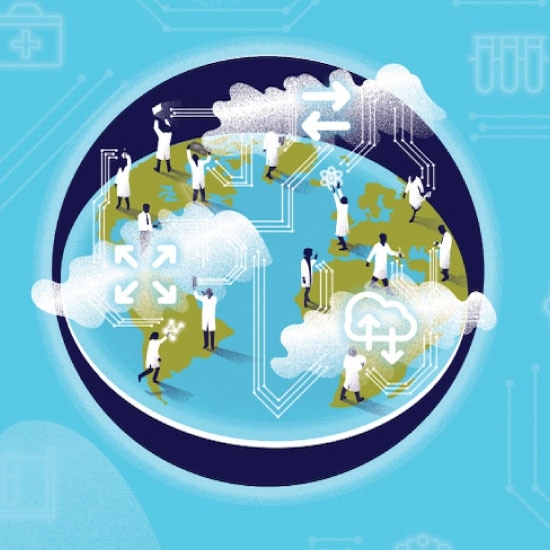While organizations across all industries can benefit, the opportunity may be especially relevant in the life sciences and health care (LSHC) industry. The global pandemic has highlighted the need for global coordination with omnichannel audiences across public, private, academia, and consortiums. This paper examines the different ways in which the cloud can enable R&D across the LSHC industry and beyond.
LSHC: What COVID-19 teaches us about cloud-enabled collaborative research
Is the pandemic a “break the glass” scenario for cloud-enabled R&D in LSHC?
The technology to bring together real-world and clinical data, securely, at scale, and at velocity—the cloud—has been there all along. By urgent necessity, the pandemic has hypercharged this transformation for global collaboration around shared research objectives.
- Pharmaceutical research is seeing unprecedented levels of collaboration. For COVID-19, 213 vaccines are in development and 319 potential treatments in progress.5
- Biopharma companies have reconfigured their individual clinical operations and trials to manage efficiency and cost, and better connect with patients.6
- Health care organizations are maturing in using advanced analytics and machine learning (ML) for diagnostics and are sharing real-world evidence from clinical notes, lab reports, pathology images, and radiology scans. Deloitte research shows that 84% of physicians expect secure, efficient sharing of patient data integrated into care in the next 5–10 years.7
- Bioinformatics have progressed to sequence and analyze the RNA of SARS-CoV-2 (the virus that causes COVID-19) to develop antiviral drugs by drawing on ML tools.8
Deloitte’s research on radical data interoperability reveals that 60% of US LSHC organizations host more than half of their applications on the cloud already.9 However, nonstandardized data infrastructures pose a challenge in coordination10 and data interoperability within and across organizations. This is where cloud technologies can help advance transformation now and into the future.
The cloud is an enabler of data, and cloud and data modernization strategies are inextricably intertwined.11 As human genome sequencing data volumes grow to an expected 40 exabytes by 2025,12 and as scientists spend up to 30%–40% of their time searching for, aggregating, and cleansing data,13 the cloud may well be a force multiplier to get drugs to market faster and cheaper. In fact, it’s already set the world record14 for elastic analysis of genomic data.15 And Deloitte research shows that shared infrastructure and resources for master protocols can reduce the research cycle time by 13%–18% and overall cost savings of 12%–15%.16 The question becomes: How does cloud enable such efficiencies and cost savings?
Innovating innovation technology for LS&HC R&D across three core approaches
Cloud data platforms
Organizations are beginning to understand a centralized data warehouse isn’t the only model. There are numerous cloud data platform options, including enterprise data management, data exchanges, open architecture strategies, the centralized data warehouse, and data lakes each with their unique advantages.
Enterprise data management
It’s common for valuable laboratory data to be saved on local hard drives, thumb drives, and storage area networks, thus introducing storage capacity, searchability, and security challenges. The cloud gives organizations various solutions to ingest, transform, analyze and share millions of existing records with flexibility and at scale to make data a reusable asset across teams. Cloud-enabled enterprise data management platforms with a shared data lake are one common solution, and our interviews revealed LSHC organizations, in particular are beginning to explore a new, emerging operating model to manage data across the organization in the form of “data-sharing neighborhoods” to generate cross-domain insights and to share data with regulators.


















